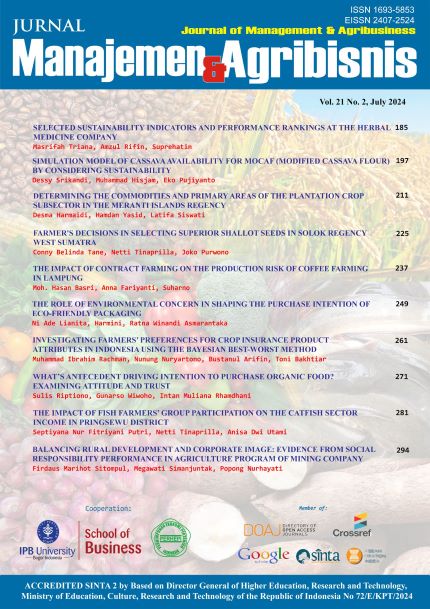Simulation Model of Cassava Availability For Mocaf (Modified Cassava Flour) By Considering Sustainability
Abstract
Background: There is a high demand for wheat flour, but the supply of it is reduced due to high prices and world oats availability because of climate change and conflicts. Cassava is processed through a fermentation process into mocaf flour and can be used as an alternative substitute for wheat flour. However, the availability of cassava has decreased in the last five years.
Purpose: This research aims to determine the factors that influence the availability of cassava by considering sustainability.
Design/methodology/approach: This research uses primary data from the Mocaf agro-industry and secondary data from the Central Bureau of Statistics website, as well as previous research. Supply chain management is used in this study with a model simulation of a dynamic system. The simulation model begins by creating a Causal Loop Diagram (CLD), building a mathematical model to formulate relationships between related entities, developing a Stock Flow Diagram (SFD), and drawing the model with Stella Software.
Findings/Result: The results show that the factors that influence the availability of cassava as raw material for mocaf are harvest growth and an increase in the purchasing price of cassava at the farmer level. The simulation results show a substitution policy of 30% and cassava harvest growth of 1% every year, with the total availability of cassava being 17 million tons. The sustainability factor which refers to the simulation results, namely from the environmental dimension, can reduce CO2 emissions. The social dimension is the absorption of rural labor and home industry labor, utilization of marginal land, increasing income, and realizing food security. The economic dimension is the added value and durability of the mocaf.
Conclusion: The factors that influence the availability of cassava as raw material for mocaf are harvest growth and an increase in the purchasing price of cassava at the farmer level. Implementation of the development scenario the availability of cassava can be fulfilled.
Originality/value (State of the art): Substitution policy for mocaf and cassava harvest growth can increase the availability of cassava and implementation of the development scenario (substitution policy of 30% mocaf and cassava harvest growth of 1%) the availability of cassava can be fulfilled.
Keywords: mocaf, model simulation, cassava, supply chain management, dynamic system
Authors
Authors who publish with this journal agree to the following terms:
- Authors retain copyright and grant the journal right of first publication with the work simultaneously licensed under a Creative Commons Attribution License that allows others to share the work with an acknowledgement of the work's authorship and initial publication in this journal.
- Authors are able to enter into separate, additional contractual arrangements for the non-exclusive distribution of the journal's published version of the work (e.g., post it to an institutional repository or publish it in a book), with an acknowledgement of its initial publication in this journal.
- Authors are permitted and encouraged to post their work online (e.g., in institutional repositories or on their website) prior to and during the submission process, as it can lead to productive exchanges, as well as earlier and greater citation of published work (See The Effect of Open Access).

